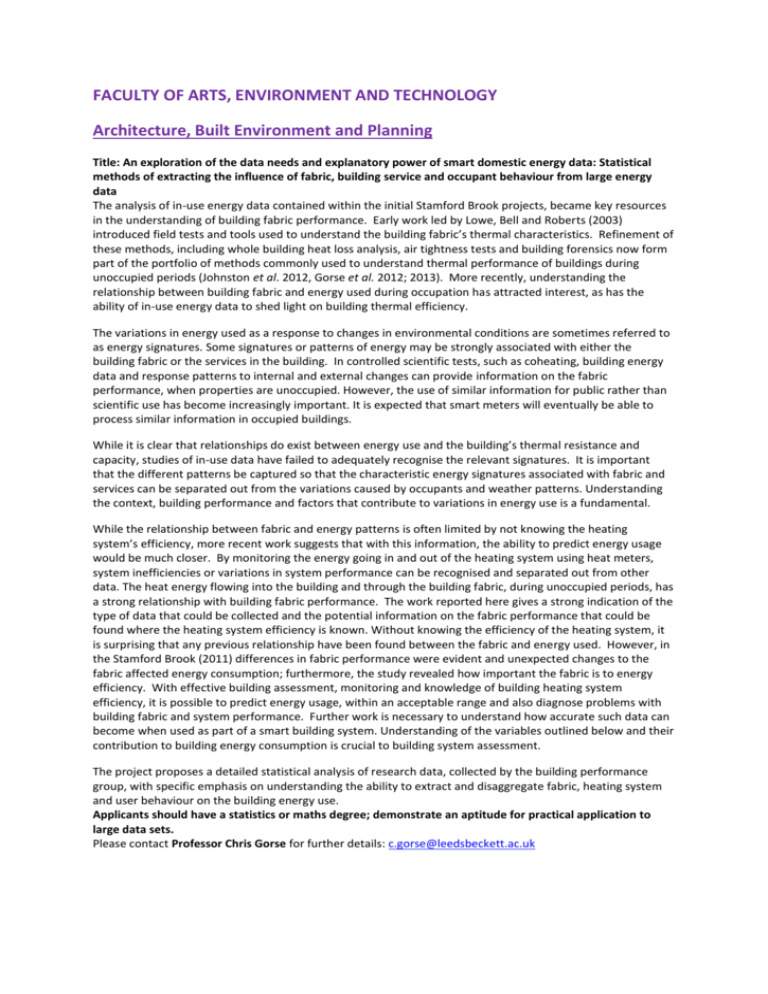Architecture, Built Environment and Planning
advertisement

FACULTY OF ARTS, ENVIRONMENT AND TECHNOLOGY Architecture, Built Environment and Planning Title: An exploration of the data needs and explanatory power of smart domestic energy data: Statistical methods of extracting the influence of fabric, building service and occupant behaviour from large energy data The analysis of in-use energy data contained within the initial Stamford Brook projects, became key resources in the understanding of building fabric performance. Early work led by Lowe, Bell and Roberts (2003) introduced field tests and tools used to understand the building fabric’s thermal characteristics. Refinement of these methods, including whole building heat loss analysis, air tightness tests and building forensics now form part of the portfolio of methods commonly used to understand thermal performance of buildings during unoccupied periods (Johnston et al. 2012, Gorse et al. 2012; 2013). More recently, understanding the relationship between building fabric and energy used during occupation has attracted interest, as has the ability of in-use energy data to shed light on building thermal efficiency. The variations in energy used as a response to changes in environmental conditions are sometimes referred to as energy signatures. Some signatures or patterns of energy may be strongly associated with either the building fabric or the services in the building. In controlled scientific tests, such as coheating, building energy data and response patterns to internal and external changes can provide information on the fabric performance, when properties are unoccupied. However, the use of similar information for public rather than scientific use has become increasingly important. It is expected that smart meters will eventually be able to process similar information in occupied buildings. While it is clear that relationships do exist between energy use and the building’s thermal resistance and capacity, studies of in-use data have failed to adequately recognise the relevant signatures. It is important that the different patterns be captured so that the characteristic energy signatures associated with fabric and services can be separated out from the variations caused by occupants and weather patterns. Understanding the context, building performance and factors that contribute to variations in energy use is a fundamental. While the relationship between fabric and energy patterns is often limited by not knowing the heating system’s efficiency, more recent work suggests that with this information, the ability to predict energy usage would be much closer. By monitoring the energy going in and out of the heating system using heat meters, system inefficiencies or variations in system performance can be recognised and separated out from other data. The heat energy flowing into the building and through the building fabric, during unoccupied periods, has a strong relationship with building fabric performance. The work reported here gives a strong indication of the type of data that could be collected and the potential information on the fabric performance that could be found where the heating system efficiency is known. Without knowing the efficiency of the heating system, it is surprising that any previous relationship have been found between the fabric and energy used. However, in the Stamford Brook (2011) differences in fabric performance were evident and unexpected changes to the fabric affected energy consumption; furthermore, the study revealed how important the fabric is to energy efficiency. With effective building assessment, monitoring and knowledge of building heating system efficiency, it is possible to predict energy usage, within an acceptable range and also diagnose problems with building fabric and system performance. Further work is necessary to understand how accurate such data can become when used as part of a smart building system. Understanding of the variables outlined below and their contribution to building energy consumption is crucial to building system assessment. The project proposes a detailed statistical analysis of research data, collected by the building performance group, with specific emphasis on understanding the ability to extract and disaggregate fabric, heating system and user behaviour on the building energy use. Applicants should have a statistics or maths degree; demonstrate an aptitude for practical application to large data sets. Please contact Professor Chris Gorse for further details: c.gorse@leedsbeckett.ac.uk Architecture, Built Environment and Planning Title: Assessing the properties of building materials and construction assemblies using non-invasive technology Through a review and application of current and developing technologies, the study will be used to assess the ability of technology to support the identification of material properties and characteristic behaviour when built. The aim will be to use the technology and supporting methodologies to identify thermal performance characteristics, defects, free water and moisture content, voids and interconnecting voids. It is also posited that the technology will assist in understanding properties of substrate materials, leading to a better understanding of component assemblies, bonding and behaviour. Use of mobile phone thermal cameras, photographic images and methods of recognising visible materials and phenomena will provide baseline information on which new data can be added. The review of the technologies and the data contributed will make an important contribution to non-destructive methods of investigation, being specifically useful to the fields of surveying and building energy efficiency. A review of new and emergent technologies will be important to this study, for example, the use of spectrometers and microwave technology to recognise material properties, identification of free water content and other properties. The study will explore the suitability of the equipment and its fitness for use (industry ready). A key question is - To what extend can current and developing technologies contribute to non-invasive identification of construction material properties in the field? The research project would be used to explore and assess the potential to obtain reliable information on the construction and material properties, using non-invasive techniques to collect the data. Applicants would benefit from graduate studies in physics, maths, electronics or computer science disciplines. Experience in construction, materials or electronics is derisible but not essential. Please contact Professor Chris Gorse for further details: c.gorse@leedsbeckett.ac.uk Architecture, Built Environment and Planning Title: Assessment of the dynamic behaviour of buildings: Understanding the relationship between heat-up and cool-down parameters and energy efficient thermal comfort. Dynamic measurement and characteristic behaviour of buildings is gaining increasing levels of interest. Thermal properties of newer buildings, with lightweight and reduced mass assemblies often have lower thermal capacity. Due to the lower thermal capacity, they tend towards greater response to heat inputs and therefore exhibit higher temperature swings, with often shorter heat up times as heat energy is introduced. Also, where heavyweight buildings are internally lined with insulation, they may behave similar to lightweight buildings, with fast heat up periods. Currently the use of internal wall insulation is being applied to existing high mass structures, with little consideration for the changes in the thermal behaviour. The change in the way the buildings are responding to heat energy needs further investigation. It is posited that through and improved understanding of the behaviour and commensurate control and heating systems, improved levels of thermal comfort and energy efficiency can be achieved. However, such controls need to account for occupancy behaviour and patterns. Constructions with high thermal mass would take more time to increase internal environment temperature after long period of no heating. Understanding the dynamic behaviour, time taken to heat up, store and release heat energy is fundamentally important if control systems are to be designed to maintain thermal comfort and energy efficiency. The project seeks to characterise, map and understand the behaviour of light weight and high thermal mass properties offering the potential to improve control systems. Applicants would benefit from graduate studies in physics, maths, electronics or computer science disciplines. Experience in construction, materials or electronics is derisible but not essential. Please contact Professor Chris Gorse for further details: c.gorse@leedsbeckett.ac.uk Closing date is midnight on 30th June 2015. Details of how to apply can be found at: http://www.leedsbeckett.ac.uk/research/research-degrees/research-studentships-and-fees-only-bursaries/







